Are you a Quiet Speculation member?
If not, now is a perfect time to join up! Our powerful tools, breaking-news analysis, and exclusive Discord channel will make sure you stay up to date and ahead of the curve.
At the moment I'm writing, only about half of the cards in Mirrodin Besieged have been spoiled, but it already looks poised to have a large impact on the Standard format in particular. I am generally more optimistic about formats than most (the last Standard format I disliked was with Affinity; I had no beef with either Faeries or Jund), but even I was starting to feel things were getting stale recently. I'm looking forward to the shakeup it'll make in Standard.
I'm not going to bother reviewing every card spoiled so far - I think we all know Peace and Pierce Strider aren't going to make the cut. If a card's uses seem obvious or it is clearly unplayable, I'll pass by. Instead, I'll only be mentioning the cards I think are either over or under hyped. Also, note that this is purely a constructed review.
I have heard a number of people talking about this guy as a possible answer to Counterbalance in Legacy, but I don't see it. First of all, if you want an answer to a resolved Counterbalance, two mana is a very awkward mana cost. If they already have the Counterbalance in play, resolving a two drop is anything but guaranteed. If this does resolve and take away the Counterbalance, you are still in an awkward position if they topdeck any kill spell. Casting something that you think is sure to resolve, then watching them [card Swords to Plowshares]Swords[/card] this guy in response to counter your spell with the Balance... seems to me like a good way to start hating Magic.
Also, this is nothing new. There are plenty of creatures that deal with enchantments already, such as Stern Proctor, Harmonic Sliver, Indrik Stomphowler, Viridian Zealot, or others, and none of them have seen significant amounts of play against Counterbalance. The best ways for aggressive decks to beat Counterbalance decks are to A. Attack their greedy manabases; B. Ignore it with Aether Vial; or C. Take it from their hand before it resolves.
The best thing about this guy is that he isn't a dead card if you are playing against a deck other than [card Counterbalance]Counter[/card][card Sensei's Divining Top]Top[/card], which makes it much more worthy of maindeck inclusion. Having versatile answers in your maindeck is always nice as long as they are still good when you play against something other than what you've expected, because it allows you to save on sideboard space. That said, I don't see how this beats out Qasali Pridemage. The Pridemage doesn't give them back their permanent if it dies, and it beats harder for the same amount of mana thanks to Exalted. If Counterbalace is heavily played, I could see running a copy or two of the Relic-Warder as [card Qasali Pridemage]Pridemages[/card] numbers five and six, but I would run the full set of Pridemages before I put in the first Relic-Warder.
In Standard, it's possible this could see some play if more artifacts start seeing significant play. At the moment I don't think that there are enough artifacts or enchantments being played to justify his inclusion, but that is of course about to change. Taking away a Wurmcoil Engine seems huge in a Boros-style deck, but again, the fact that they can get it back opens the door to huge blowouts. If you take away their Wurmcoil and then attack, they can kill the Relic-Warder in response to block your best guy with Wurmcoil Engine, gaining six in the process, which seems basically GG for a Boros deck. I expect Wurmcoil Engine to begin to see more play than it currently has due to its new best friend, Treasure Mage, so this situation is going to come up more often in the future than it currently does.
I expect this to see some play, but the opportunity for blowouts will stop it from becoming widespread.
Speaking of Treasure Mage, here he is:
As Paul Newman said in the great movie Butch Cassidy and the Sundance Kid, "I've got vision and the rest of the world is wearing bi-focals!" That's how this guy feels about his little brother, Trinket Mage.
Not long ago, Nick Spagnolo popularized UB with a Trinket Mage package for one or two Everflowing Chalice, along with an Elixir of Immortality and Brittle Effigy. I was never too big a fan of that, as it just didn't feel powerful enough to me. Treasure Mage, however, is another story. The most obvious target to get with him is Wurmcoil Engine, but others exist. The problem with most six drops is that you don't want to draw them in the early game, as they will simply clog up your hand until the late game when you can cast them. With Treasure Mage, you can cut one or two of your expensive bombs and replace them with the Mage. This will let you improve your early game without significantly hurting your chances of drawing a bomb when you need one. If you were playing four Wurmcoils, for instance, you could cut one or two for Treasure Mage and have the same chance of drawing a Wurmcoil when you need one while also having more blockers in the early game for [card Goblin Guide]Goblin Guides[/card] and their ilk. While Wurmcoil hasn't seen much play so far because it has been overshadowed by the Titans, I think the fact that it is now easily searchable will lead to a significant upswing in play.
Treasure Mage also opens the door to other artifacts that haven't seen significant play so far. One that comes to mind is Mindslaver. Mindslaver is an incredibly powerful effect that can turn the game around, but it hasn't seen much play since it was reprinted. My guess for why is thanks largely to [card Jace, the Mind Sculptor]Jace, TMS[/card]. In original Mirrodin, you could Mindslaver someone, wreck their hand, and then they were just dead. Today, if you Mindslaver someone and they have Jace in play, they can still just beat you - especially if you do the Mindslaver over two turns instead of one. An extra turn allows them to Brainstorm any particularly devastating cards away with the Jace, hopefully limiting the damage you can inflict. Also, given the other potential six drops available today, Mindslaver doesn't tower above the other possible uses of mana the way it once did. There weren't nearly as many good uses of large amounts of mana in original Mirrodin block as there are today. That said, Mindslaver can still wreck an opponent if it hits. I think that a one-of Mindslaver in a deck already running Treasure Mage could be devastating, and is certainly worthy of consideration.
This is an interesting one. Its closest recent relative that comes to mind is Martial Coup, which was good enough to see some play last year. Unfortunately however, the extra creature token does nothing if there are no creatures on the board, or if you are in the early part of the game. When I played Coup, I enjoyed playing it as early as turn three or four, just to make a couple of blockers to buy me time against Goblin Guides and such. Phyrexian Rebirth can't do that. It is also no good if there are no creatures in play, or if there are a small number of opposing creatures. If the opponent is sitting on a Frost Titan, ripping Rebirth is going to be something less than amazing.
Against any swarm deck, however, this is going to shine. I would much rather have this than Sunblast Angel against an Elf deck. The fact that Sunblast can not kill creatures that are untapped, whether because they were just summoned or because they have Vigilence, is often quite annoying. The pluses in Sunblast's column are that it is good even if no creatures are in play, or at least not dead, and it has flying. The Rebirth destroys all creatures, tapped or not, which is nice. If there are no creatures in play, or very few like in a control mirror, then you would much rather draw a Sunblast. Against a swarm deck, however, this feels much more threatening than the Angel. Not only do you [card Wrath of God]Wrath[/card] their board, you also get a creature large enough it will often act as a walking [card The Abyss]Abyss[/card]. If you make a large creature after Wrathing them, not only do they no longer have any guys, they are now on a short clock. If they suddenly lose their army and have to block with any creatures they draw to avoid dying, they are going to be in a bad spot.
I don't expect this to see much adoption now, but it may see play later on, especially if Day of Judgment is absent from the 2012 Core Set or if you care about playing Block. I'd recommend trading for them at a buck or two as they aren't going to go down in price much, but if they start to see play they'll rise significantly.
As a devout blue mage, it pains me to say this, but I'm pretty sure this card sucks. The most recent equivalent to Blue Sun's Zenith is Mind Spring, which saw some play as a one or two of last year in builds of UW Tapout Control. The problem with Tapout, however, and the reason it fell from favor, is that it is weak to more counter-based Control builds. Tapping out for a Mind Spring is pretty good when you are playing against a creature deck and can breathe for a turn, but if the other guy is playing some combination of Mana Leak, Spell Pierce, Deprive, Stoic Rebuttal, Cancel, and Negate, it makes tapping out for a Mind Spring a significantly less appealing proposition. Most Control decks are playing more counterspells now than when Mind Spring was around, largely because Bloodbraid Elf has left the format and turned counterspells from embarrassing to viable. The difference between this and Mind Spring, obviously, is that Blue Sun's Zenith is an instant. That is an upgrade well worth the one extra blue required for Zenith. I love card draw as much as the next guy (really, probably more than the next guy), but this just doesn't seem as good as [card Jaces Ingenuity]Jace's Draw Three[/card] to me, and when was the last time you saw [card Jaces Ingenuity]Jace's Draw Three[/card] in a tournament list? It has been a while, unless I missed one. If Blue card draw is what you want, a Jace of either size is just better most of the time. It is just embarrassing to cast Ingenuity when the other guy has a Mind Sculptor in play, let me tell you.
Also, look at the mana. For five mana (and 2UUU at that), Zenith draws you two cards, Ingenuity draws you three. You have to pay seven mana, a full two more than Ingenuity, before you are getting more cards than an Ingenuity would give you. The jump from five to seven mana is huge - a minimum of two turns, more likely three or more.
I've been ignoring the Zenith's reshuffling trigger in my previous arguments. I don't think that it will matter very much in most games, and the arguments against it are enough to make me want to build a deck without Zenith, even if the card could provide some benefit. I'm not sure exactly how to evaluate that aspect of the card, and it is possible that it is enough to push it over into playable.
I was quite excited about this one for Control mirrors when I first saw it, but since then my interest has cooled. In previous days, a card like this could blow a game open if it resolved, but I don't think it will see much play today. Current Control decks are playing more creatures than days bygone, and more importantly more 1/xs. UB Control frequently has Sea Gate Oracle and/or Vampire Nighthawk, and most UW control decks today are playing with Squadron Hawk, which makes it quite unappealing to invest in an x/1. I have been playing more with UW than UB, but I have heard many UB players say they board out their Oracles and any Nighthawks for games two and three. If that holds true, bringing in a Commando or two from the board could be a blowout for you. Given that it is less than stellar if they don't bring them out, however, and the fact that they could always bring them back in for game three, I won't be playing any Commandos in my 75 anytime soon.
This is my pick. This is the one. I am more excited by the seemingly humble Go for the Throat than any other card spoiled so far, for several reasons. First, it kills Grave Titan. Some cards or decks are so important that they warp the format around them, even if they see relatively little play. Bloodbraid Elf and Bitterblossom are two examples of recent format warping cards - you simply could not ignore their existence when deckbuilding and expect to win, even if only a small number of people in your area were playing them. Looking a little further back, Flametongue Kavu invalidated playing expensive creatures with four or less toughness simply by existing, even though not every deck played him, because if you played a four toughness creature for four mana and they FTKed it you would lose an enormous amount of value. You had to play creatures that cost a small enough amount of mana that you didn't lose too much value if they died to FTK, or else creatures big enough that they survived 4 damage. I feel Grave Titan is a similar format warping card, and Go for the Throat is going to change that significantly. The reason Grave Titan is so important now is because there are no cards in Standard that could target and kill a large Black creature other than the rarely-played Journey to Nowhere. If Grave Titan resolves, he isn't dying. UB Control's entire plan against Aggro decks is to live long enough to cast Grave Titan, because when it hits play it is going to dominate the game and there is nothing opposing players can do about it. It's so game threatening that in UB Control mirrors, players even often board in the horrendous Memoricide, just so they can try to stop their opponent's Grave Titans before one hits play. There's simply nothing they could do about one if it were to hit play. The fact that there will exist a way to kill Grave Titan, which is not dead if the other guy doesn't have Grave Titan, is going to be huge. UB Control can no longer just race for a Titan against Vampires and let it run away with the game, and the mirror match is going to get much more interesting.
Second, on the subject of killing large Black creatures: how about them [card Abyssal Persecutor]Persecutors[/card], eh? I haven't played any UB Control with Abyssal Persecutor, because you had to play awful cards like Consuming Vapors to get rid of it. Now you get to play with Go for the Throat, which is good instead of awful. Upgrade! I am going to be working on lists that start with 3 Persecutor, 4 Go for the Throat, 4 Jace TMS, some other cards for quite a while.
At the moment, one of UB Control's worst matchups is Boros. Phyrexian Crusader in the sideboard seems like it will have a tramendous effect on that. Being protection from both of their colors, he is going to be invulnerable to everything they have. The fact that he is Infect is crucial here - he can block and kill a Plated Geopede or Steppe Lynx regardless of how many Landfall triggers have occurred that turn.
Take that, Blue decks! Haha!
Thrun is certainly a kick in the teeth, but don't think you can just play a Thrun and watch the Blue mages of the world scoop up their cards. Even in the current environment, Blue decks have [card Squadron Hawk]Squadron Hawks[/card] and [card Sea Gate Oracle]Sea Gate Oracles[/card] to chump with until they can get any of their Titans online, and Thrun doesn't fight very well against either Squadron Hawk or Grave Titan. If Thrun proves to be a significant threat, Wall of Tanglecord is another excellent answer. Tanglecord is already seeing play in Extended as an answer to Great Sable Stag from Faeries, but it hasn't passed on to Standard yet. If Thrun starts popping up, I'd expect to see the [card Wall of Tanglecord]Wall[/card] make its way into sideboards in Standard, too.
I see another problem with Thrun besides the existing easy answers. He also doesn't have a home. I can't think of an existing deck that really wants something like Thrun. I suppose you could put him in a RUG type deck, but that doesn't seem like a good fit. The advantage RUG is supposed to have over other decks is in its mana, coming from [card Lotus Cobra]Lotus Cobras[/card] and [card Oracle of Mul Daya]Oracles of Mul Daya[/card]. RUG wants to play a Titan on turn four, not a four drop on turn three. If it is playing Thrun on turn three, then its Oracles are coming out a turn late, and it isn't abusing its internal synergy - it's just throwing out a guy a turn early. That might be good enough, but it isn't abusing the synergies of the current breed of RUG decks. I'd like to play a RUG with Thrun that looked something like this:
3 Thrun
4 Nest Invader
4 Lotus Cobra
3 Inferno Titan
4 Jace, the Mind Sculptor
4 Mana Leak
4 Lightning Bolt
4 Acidic Slime
4 Preordain
26 land
This kind of deck would be less about abusing the [card Jace, the Mind Sculptor]Jace[/card]-Preordain-[card Oracle of Mul Daya]Oracle[/card]-[card Lotus Cobra]Cobra[/card] engine and would play more like a midrange beatdown deck that also got to play Jace. With Nest Invader and [card Lotus Cobra]Cobra[/card] you have eight ways to turn three a Jace, which is very similar to cheating. That also gives you the same chance to turn three a Thrun, which, next to the [card Lightning Bolt]Bolts[/card] and [card Nest Invader]Invaders[/card], should give you a fairly good game against aggro.
The only other deck I can think of that plays Green in Standard at the moment is Flores Wave, the UG Genesis Wave deck that Conley Woods recently placed with at the SCG Open. That deck is built on gaining a quick mana advantage and abusing that with high cost spells such as Titans and Genesis Wave. Many hands in that deck lead to a turn three Titan. If you curve turn one [card Joraga Treespeaker]Treespeaker[/card], turn two level it and play a Lotus Cobra, turn three play a land and Titan, why would you want Thrun? Where is he supposed to fit in the curve? You want to cast him instead of Primeval Titan on turn three? Do you want to cast him turn four, after your [card Primeval Titan]Primeval[/card] has gotten you two extra lands? Those seem less than stellar to me.
Thrun is extremely powerful and I am sure he will see play, but don't just feel you can add him to any deck with Green mana and expect to turn any Blue deck into a bye.
Yeah, that'll do. I can work with that. Tezzeret, like [card Tezzeret the Seeker]his predecesor[/card], can be quite powerful in the right deck, but must be built around to use. He is not like [card Jace, the Mind Sculptor]Jace[/card]--you can't just add him and some [card Island]Islands[/card] to any deck to make it better. As I see it, there are two ways to go with Tezzeret--you can either go all in and play with a bajillion artifacts, or you can play him in a deck with a couple of artifacts for some random value.
Suppose you go for something like this:
The Clap
4 Tezzeret, Agent of Bolas
3 Jace, the Mind Sculptor[/card]
4 Everflowing Chalice
4 Sphere of the Suns
4 Spell Pierce
3 Mana Leak
4 Preordain
4 Wurmcoil Engine
2 Treasure Mage
1 Titan Forge
3 Contagion Clasp
4 Inkmoth Nexus
20 other land
SB
3 Titan Forge
2 Treasure Mage
1 Mana Leak
4 Wall of Tanglecord
some other cards
I have to say, I like the idea of seven Blue Planeswalkers in a deck. While I just threw this together while chatting with my buddy last night, I think that something like this has serious potential with some fine tuning and tweaking. Playing Treasure Mage allows you to effectively play six Wurmcoil Engines, which, with the [card Contagion Clasp]Clasps[/card] to kill off various [card Steppe Lynx]Lynxes[/card] and [card Plated Geopede]Geopedes[/card], should make your Aggro matchup fairly good. After boarding you get to bring in two more Wurmcoil Searchers and the [card Wall of Tanglecord]Walls of Tanglecord[/card] for further defense. Against any Aggro deck you would play as Control, racing for the nigh-unbeatable Engine. With eight mana producers, you could have a turn four Engine fairly consistently. Tezzeret, of course, could also animate your [card Everflowing Chalice]Chalices[/card] and whatnot, making attacking into you with [card Kalastria Highborn]Grizzly Bears[/card] laughable.
Against any control deck, you have seven counters to push through your Planeswalkers. Your Clasps, with either the Titan Forges or the Inkmoth Nexus (Think: Blinkmoth Nexus with Infect!), grant you inevitability in the long game. I'm sure the numbers could use tweaking, but I think the general idea is solid and will be a player in the metagame ahead.
The other option with Tezzeret would be to play just one or two of him in a more traditional UB Control list. If you were already playing with several Everflowing Chalices and a Trinket Mage package, say an Elixir of Immortality and a Brittle Effigy or two, adding one Tezzeret would grant you significant value for fairly little investment.
I like this quite a bit. It grants you late game inevitability if it resolves, and it plays extremely well with counterspells. I could see this easily fitting into Control decks, whether they play any way to Proliferate or not. Simply pooping out a 9/9 every third turn while holding up counters/instant speed removal seems reasonably good, if not amazing, but it could get out of control rather quickly if you had any way to Proliferate as well.
Sphere of the Suns' closest comparison is clearly Everflowing Chalice. Chalice has seen some play as a one-or-two-of in some Control decks, especially those playing Trinket Mage, though its adoption has not been terribly widespread lately. The option to turn three a [card Jace, the Mind Sculptor]Jace[/card] is excellent, but in a Blue mirror it is often unused. If you tap out turn two for a [card Everflowing Chalice]Chalice[/card] you are leaving yourself open to a [card Jace Beleren]Baby Jace[/card] if they won the roll. Even if you are on the play, tapping out turn three for a [card Jace, the Mind Sculptor]Big Jace[/card] is often asking to lose, as they can counter it and then have free reign on their own turn. Another strike against the Chalice is the fact that it has very little impact late in the game. If you are past turn four or so, an Everflowing Chalice is probably not high on your list of dream topdecks.
That said, however, I like Sphere of the Suns quite a bit. The biggest upside it has over the [card Everflowing Chalice]Chalice[/card] is that it produces colored mana. This means that it is much more viable an option to play a three color deck now than it was before, or at least splash a third. Sphere also gives us eight instead of [card Everflowing Chalice]four ways[/card] (exempting Scars of Mirrodin's [card Copper Myr]mana myr[/card]) to have four mana on turn three in a non-Green deck, which opens some doors. Most Blue decks, when playing against Aggro decks, simply want to stall the game as long as possible, knowing that their superior card quality will win them the game if they survive long enough to start casting their high-impact cards like [card Grave Titan]Titans[/card] or [card Wurmcoil Engine]Wurms[/card]. Having more acceleration consistently available means that Control decks may replace some of their early defense with acceleration, racing to the late game. Who cares if you can't Mana Leak a turn two Plated Geopede because you tapped out to play a Sphere of the Suns, if it means you have a turn four [card Frost Titan]game ender[/card]?
Sphere of the Suns could also fit in any artifact-centric deck, as it counts for Metalcraft and can attack even after it has run dry if animated by Tezzeret, Slave of Bolas. If you have a Contagion Clasp, of course, you can stop it from running out.
If we had Sphere of the Suns replacing Everflowing Chalice, I doubt the Sphere would see much play, but the fact that we can play both is opens some exciting doors.
Thanks for reading
Brook Gardner-Durbin


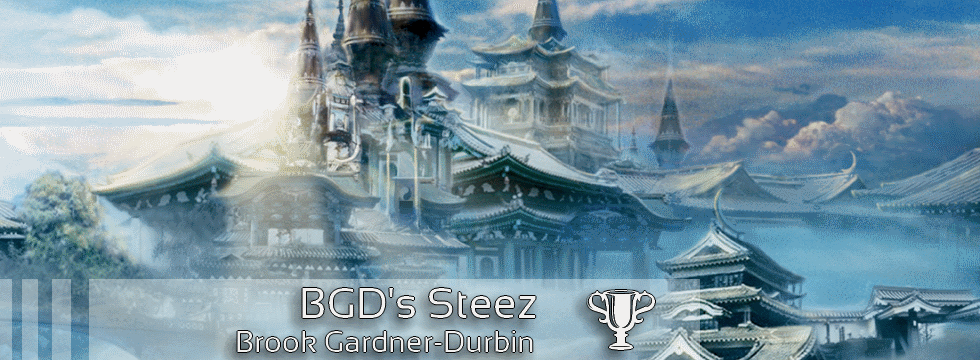
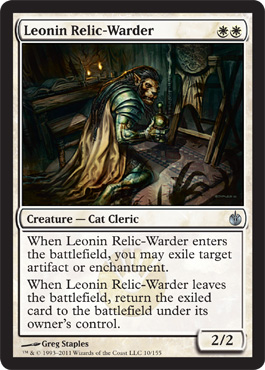


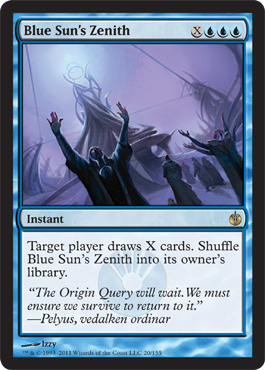

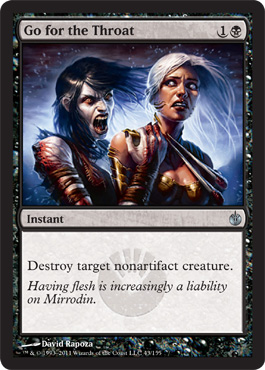

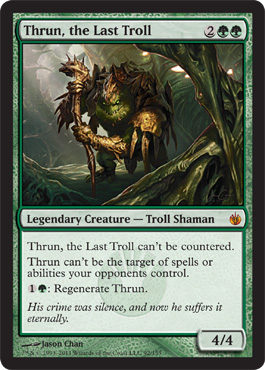
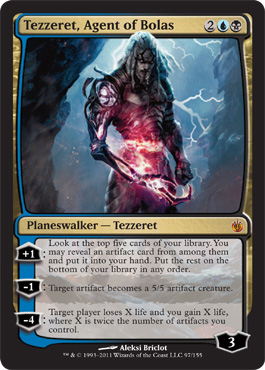

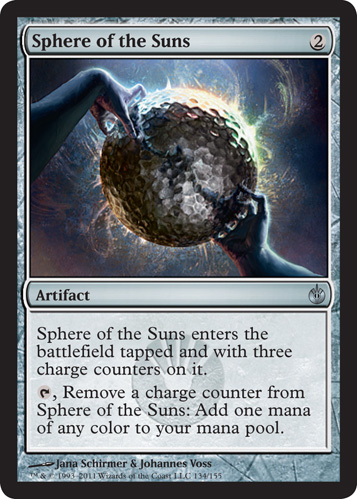


Pretty sure Go For the Throat just further strengthens Faeries, which is not something we want to see
True, the ability to kill a Demigod of Revenge or Putrid Leech seems like a great gain, but that's only really relevant in the Jund matchup. LSV just said his worst matches at the GP were with Valakut decks, where Go for the Throat v Doom Blade is basically irrelevant.
True, but it shores up other matchups very easily. Right now Faeries is fighting between 2-4 different removal options to find the best one, this pretty much ends the discussion (except against the Tempered Steel deck, I guess). Works on Jund, gets Knight of the Reliquary better if they were using Grasp of Darkness or Agony Warp. I don't think it "breaks" the deck or anything, but it takes a card slot that previously had some disadvantage to it and required a choice and replaces it with a card that is strictly better a vast majority of the time, closing a small loophole in the Faerie player's control. Not good for Faerie haters (which I'm not).
Good stuff! Forgot to metion the Tezz- Inkmoth interaction though, thats the sickness!t
Flash Fact: Counterbalance works slightly differently from how you're thinking.
" Casting something that you think is sure to resolve, then watching them Swords this guy in response to counter your spell with the Balance… seems to me like a good way to start hating Magic."
Counterbalance's Oracle text:
"Whenever an opponent casts a spell, you may reveal the top card of your library. If you do, counter that spell if it has the same converted mana cost as the revealed card."
If you opponent plays a Swords to Plowshares in response to your spell, the opponent is too late for triggering Counterbalance.
The more you know!
I did like the article though!
Oh Miles, you'd think that, but the Head Judge at the SCG KC Open ruled the opposite in a match of mine. He backed the game up and made us replay the situation you're describing.
@Mike: as I'm sure you're not aware, Brook has been playing Countertop since the stone age, so I'm sure he knows how it works. I know this because I know him personally.
Great Article Brook. I do have to disagree and say that I think the blue senith will see play… in High Tide/Time Spiral decks. Maybe as a 1 or 2 of.
*Miles
Actually, I stand corrected. Counterbalance only triggers when they cast the spell so if it isn't in play at the time the spell hits the stack it won't matter if it is in play before the spell resolves. The Relic-Warder is slightly better than I had thought, but I stand by it being strictly worse than Pridemage in any deck that can afford the green mana.
Appreciate the backup from everyone, but Miles was right and I was wrong.